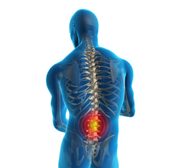Comparing Options
Comparing Treatment Options
How Does Non-Surgical Spinal Disc Decompression Compare to Other Treatment Methods?
There are several treatment options a patient may consider, and these may include:
- Non-Surgical Spinal Decompression
- Oral and/or Injected Medication
- Physical Therapy
- Chiropractic Treatment
- Surgery
Non-Surgical Spinal Decompression
Non-Surgical Spinal Disc Decompression provides relief to severe back and neck pain sufferers by gently reducing the pressure within spinal discs. These bones of the spine are slowly and methodically separated using specialized Spinal Decompression equipment (Kennedy Neural-Flex Decompression table). As the vertebrae are separated, pressure is slowly reduced within the disc (intradiscal pressure) until a vacuum is formed. This vacuum “sucks” the gelatinous center of the disc back into the disc thereby reducing the disc bulge or disc herniation. Significant disc bulge reduction removes pressure off the spinal nerves and drastically reduces pain and disability. This “sucking” vacuum also pulls much-needed oxygen, nutrients and fluid into injured and degenerated discs allowing the healing to begin.
The treatment motion is computer controlled to provide gentle and painless decompression of the injured spinal discs. The latest Spinal Decompression treatment protocols have been demonstrated by scientific research to be up to very effective. Comparisons of pre-treatment MRIs to imaging taken after the completion of treatment have shown significant, often dramatic, reductions in disc bulges and disc herniations.
Oral and Injected Medications
The majority of treatment options available to sufferers of disc bulges and disc herniations are directed at masking pain, reducing inflammation or relaxing muscles in spasm with the use of medication. The effectiveness of these treatments lasts for as long as you take the medication even though the actual problem still exists behind the numbing effects of the drugs. Spinal injections can also be used to reduce pain and inflammation near the spine. Several varieties of spinal injections exist including cortisone injections for inflammation, epidural pain injections and “nerve blocks”. However, injections are only a temporary solution and carry with them other inherent risks (eg. infection, thinning of the cartilage around the join joint, weakening of surrounding ligaments etc.)
Physical Therapy
Physical therapy methods vary by practitioner. Some methods provide modest benefit for disc herniation problems while others provide little to no benefit. The least effective methods focus entirely on pain control and, therefore, have the same limitations as noted above with medication – namely that they are temporary and do not address the source of the pain. These methods include the application of ice, electrical stimulation, ultrasound, cold laser treatments, massage, vibratory massage, iontophoresis (combining electrical stimulation with medication) and phonophoresis (combining ultrasound with medication). Muscular strengthening protocols, the mainstay of many physical therapy clinics, are often recommended to improve “core” spinal strength. These methods have been demonstrated to be beneficial at preventing future injury. However, research indicates that exercising unstable spinal regions can actually cause greater harm to the delicate disc and nerve tissue. Therefore, muscle stretching and strengthening techniques should be considered for only mild to moderate spinal disc problems. Self-directed exercise routines and exercise programs created by personal fitness trainers would also apply to the previous statement.
Chiropractic Treatment
Research on chiropractic treatment of low back pain is quite favorable. However, severe disc bulges and herniations are less likely to respond to chiropractic adjustment intervention. Chiropractic care is recommended more often for mild to moderate cases of disc-related spinal pain. In fact, large disc herniations are considered a contraindication to certain chiropractic treatment methods. A Doctor of Chiropractic is the most qualified professional to determine whether care would or would not be beneficial in your particular case. If chiropractic intervention is not appropriate for you or does not achieve adequate recovery then Non-Surgical Disc Decompression would likely be recommended.
Surgical Treatment Options for Disc Herniations and Disc Bulges
Surgery should always be considered the last option. Surgery is by far the most dangerous of all available treatment options AND is associated with the lowest success rates AND has the longest recovery time AND is the most expensive AND is the most painful. In very rare circumstances, surgery cannot be avoided. Patients that may have no other option than to forego conservative treatment and receive surgery include those with progressive neurological deficits (motor weakness, loss of reflexes, etc.) or cauda equina syndrome (bilateral sciatica, saddle dysesthesia, motor weakness in the lower extremities and/or loss of bowel and bladder control). Nearly all other cases should consider less dangerous, non- invasive interventions first.
Surgery is not without its risks. According to a study published in the respected medical journal, Spine (1991; 16[1]), 1 out of every 575 lumbar discectomy surgeries (one of the most commonly performed low back spinal surgeries) will involve severe vascular complications. Of these complications 37-61% will result in the death of the patient. In other words, approximately 1 out of every 1000 lumbar discectomy patients will die as a direct result of the surgery.
The risk associated with surgery is not always the procedure itself, but the general anesthesia necessary to perform the operation. A small percentage of patients die every year or are permanently disabled as a direct result of both properly and improperly applied anesthesia. Some surgeons are incorporating epidural anesthesia into their less-invasive surgical protocols in an attempt to reduce some of these risks.
The failure rate of surgery for back pain and neck pain is very high. Some 200,000 patients undergo lumbar spine surgery every year. On average, approximately 53 percent of all lumbar spine disc surgeries fail to relieve symptoms according to a study published in International Orthopedics (1987; 11:255-259). The results from another study published in Spine (2004; 29[17]:1931-7) showed that 20-40 percent of patients will fail to gain the desired outcome and 10 percent of patients will be worse after the initial surgery. The same study followed the progress of 3,362 patients that received spinal surgery. The results of a SF-36 Health Survey showed that patients with a history of spine surgery faired significantly worse on areas such as physical functioning, general health and mental health compared to those patients with no prior history of spine surgery. The researchers went on to say that “previous back surgery is associated with significantly worse general health status than those without surgery…”
Treatment Non Invasive Safe Success Rate Painless
Non-Surgical Spinal Decompression Therapy YES YES EXCELLENT YES
Laminectomy (Surgical Excision of Herniated Disc) NO Standard Surgical and Anesthesia Risks Depends on Severity of Condition and Skill of Surgeon NO
Discectomy (Surgical Removal of Diseased Disc) NO Standard Surgical and Anesthesia Risks Standard Surgical and Anesthesia Risks NO
IDET (Intradiscal Electrothermal Treatment) NO Standard Surgical and Anesthesia Risks Standard Surgical and Anesthesia Risks NO
Percutaneous Laser Disc Decompression NO Minimal Surgical Risks Usually Good Mild
Do Nothing YES Condition Usually Continues To Get Worse NONE: Can Have Very Poor Prognosis Very Painful, Not Advised



